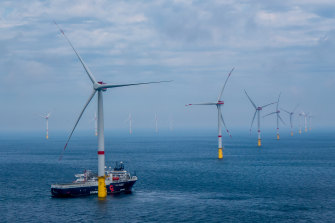Victoria’s plan to build Australia’s first offshore wind farms has been declared a game-changer by renewables backers, with Premier Daniel Andrews announcing the state will set energy targets for wind power to generate up to 6100 jobs.
Mr Andrews, in his first major keynote speech since the COVID-19 pandemic began, said the state’s energy investment represented a new phase of the Australian federation in which state governments – not the Commonwealth – were responsible for the reform agenda that boosted productivity and living standards.
The Veja Mate offshore wind farm in Germany.
“I’m very keen for a national government that’s got some policy ambition and who knows that if you haven’t got a reform agenda, then you ain’t got an agenda at all,” he said. “I believe that the biggest drivers of growth over the next 10 years will be states and territories.”
Offshore wind farms that will bring at least two gigawatts (GW) of energy online – enough to power 1.5 million homes – will be built by 2032, Mr Andrews said in a speech to the Committee for Economic Development of Australia on Friday. New targets have been set to generate four GW by 2035 and nine GW by 2040.
The first power from offshore wind is expected to flow by 2028 following a competitive process, with the region off Victoria’s blustery coastline among the best for wind energy generation in the world, the government says.
Studies have shown the state has the potential to support 13 GW of capacity from coastal regions by 2050, which is five times the state’s current renewable energy generation, the government says. If this full potential was reached, the offshore wind projects would generate up to 6100 jobs, Mr Andrews said: 3100 jobs in development and construction and a further 3000 ongoing operational jobs.
Representatives for Australia’s largest renewable energy investors described Friday’s announcement as a “game-changer”.
“Major global and Australian investors have rapidly positioned to secure development sites in Victoria and other states,” said Simon Corbell of the Clean Energy Investor Group, which represents 18 investors with $24 billion in Australian renewable energy assets. “There is huge appetite from investors for offshore wind development in Australia.”
In November last year, Victoria pledged about $40 million under the Energy Innovation Fund for feasibility studies and pre-construction development for three major offshore wind proposals: Star of the South, Macquarie Group and Flotation Energy.
The most developed of the proposals, Star of the South, received $19.5 million from the state government to support pre-construction work, including site investigations in Gippsland and offshore geotechnical work.
On Friday, Flotation Energy – a company seeking to develop the 1.5-gigawatt Seadragon offshore wind project in Bass Strait – said the Andrews government’s commitment could unlock billions of dollars of new investment, create new skilled jobs and opportunities for local supply chains.
“Offshore wind is a key enabler in the energy transition as it delivers large scale, consistent and reliable renewable energy that complements onshore wind and solar,” Flotation Energy Australia managing director Tim Sawyer said.
Enviornment groups also welcomed the announcements, saying offshore wind was a critical sector for the state’s transition away from coal-fired power.
“Establishing an offshore wind sector in Victoria will be critical for delivering the deep emissions cuts needed to avoid worsening climate impacts” said Friends of the Earth’s renewable energy spokesperson Pat Simons.
Gippsland and Portland West are particularly attractive for offshore wind, with world-class wind speeds in terms of both strength and consistency, existing transmission infrastructure, a large area of shallow ocean – less than 50-60 metres deep – suitable for fixed-platform turbines; and ports that can support construction, operation, and maintenance requirements, according to the government’s offshore wind policy.
Victoria has committed to reducing its emissions by 2030 and reaching net-zero emissions by 2050.
A guide to the environment, what’s happening to it, what’s being done about it and what it means for the future. Sign up to our fortnightly Clear Air newsletter here.
Most Viewed in Environment
From our partners
Source: Read Full Article

